Observations of Rhododendron yakushimanum
Anthony M. Shammarello, South Euclid, Ohio

|
|
A new Shammerello cross
R. yakushimanum x 'King Tut' Tentatively named 'Yaku Prince' Shammerello Photo |
During the past ten years it has become apparent that
R. yakushimanum
and its crosses that I made with
R. catawbiense
hybrids, are resistant to insects and root rot. The indumentum under the leaf repels or makes it difficult for lace bugs, white flies and red spiders to feed. As compared to standard rhododendron varieties, spraying is not necessary to keep these insects under control.
Rhododendron growers are familiar with the dreaded root rot disease to which our native and standard varieties of all ages are susceptible in particular the prized Rhododendron 'Boule de Neige'. Root rot is induced by excess moisture which activates spores in the soil from a dormant to a viable stage. The rot process is slow; it may not become apparent until the year following a year of excess moisture. Perfect drainage to an extent inhibits root rot diseases. However, the soil texture, amount, and frequency of watering play a part in control.
Surprisingly,
R. yakushimanum
and its hybrids seem to tolerate conditions which easily affect the standard rhododendron varieties.
Dr. Hoitink, pathologist at the Ohio Agricultural Research and Development Center, Wooster, Ohio, indicated that symptoms of infection were not evident until three months after inoculation. The susceptible
R. carolinianum
and 'Boule de Neige' died within 1 - 2 weeks. In view of my experience and Dr. Hoitink's laboratory work,
R. yakushimanum
will become infected only if subjected to severe stress.
This is a monumental advantage considering loss sustained by nurserymen and owners of established plantings which can not be replaced. New chemicals applied at the correct time may give control. Inherent resistance qualities overcome this need for treatment.
Aside of being practically troublesome free,
R. yakushimanum
and most of its hybrids are desirable plants in many respects which I cannot refrain to outline. In plant habit it is a bushy grower, branches to the ground, with a near perfect mound, and is considered a dwarf by comparison to the tall growing varieties. The rate of growth of the hybrids is comparable to 'Boule de Neige'; the species is less vigorous. In contrast to 'Boule de Neige' its foliage is covered with a silver sheen which is conspicuously attractive. It comes into bloom here about May 20th. The hybrids exhibit density of color in comparison with the species in which apple blossom pink predominates.
During the process of flowering there is an appealing color contrast; the terminal flower buds upon opening are deep pink to almost red, the just opened florets, encompassing most of the truss, are a vibrant chiffon pink, the lower florets that opened first fade apple blossom pink or white. This color combination of pink shades create an artistic and beautiful arrangement. Fortunately the plant is very hardy and flower buds are hardy to 15 to 20 degrees below zero.
This species is one of the great gifts from Japan and I hope that it and its off-springs will soon be commercialized in our country.